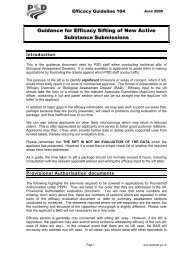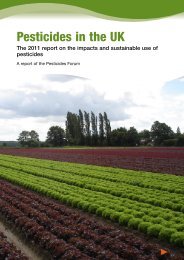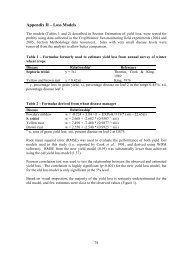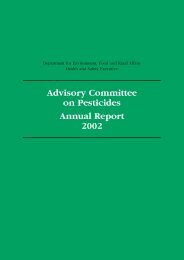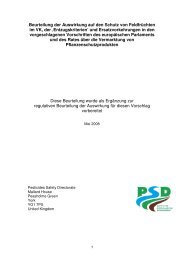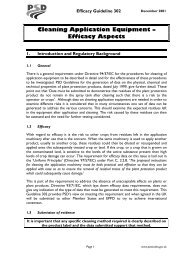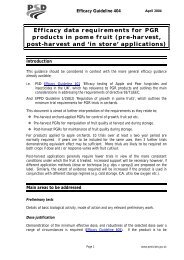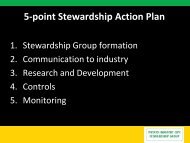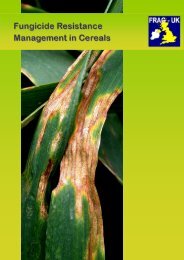Advisory Committee on Pesticides Annual Report 2001
ACP Annual Report 2001 - Pesticides Safety Directorate
ACP Annual Report 2001 - Pesticides Safety Directorate
Create successful ePaper yourself
Turn your PDF publications into a flip-book with our unique Google optimized e-Paper software.
<str<strong>on</strong>g>Advisory</str<strong>on</strong>g> <str<strong>on</strong>g>Committee</str<strong>on</strong>g> <strong>on</strong> <strong>Pesticides</strong> <strong>Annual</strong> <strong>Report</strong> <strong>2001</strong><br />
for incomplete oral absorpti<strong>on</strong>) were applied to the NOAEL of 4.89 mg/kg<br />
bw/day. This resulted in a systemic short-term AOEL of 0.02 mg/kg bw/day.<br />
The informati<strong>on</strong> submitted <strong>on</strong> operator exposure was c<strong>on</strong>sidered sufficient to<br />
support approval of ‘C<strong>on</strong>serve’ for use <strong>on</strong> ornamental crops. No further data<br />
were required. However, use of protective gloves and coveralls when handling<br />
the product and during applicati<strong>on</strong> when applying by hand-held equipment or<br />
handling c<strong>on</strong>taminated surfaces was recommended. Modelling of operator<br />
exposure with this level of pers<strong>on</strong>al protective equipment (PPE) predicted<br />
exposures at or below the AOEL.<br />
The evaluati<strong>on</strong> indicated that recommended uses of ‘C<strong>on</strong>serve’ might result in<br />
exposure of bystanders, but this was acceptable, as the extent of exposure<br />
was likely to be significantly less than the AOEL. With respect to worker<br />
exposure, the estimated systemic exposure from the use of ‘C<strong>on</strong>serve’ under<br />
cover (glass or plastic) was less than the AOEL. Therefore, worker exposure<br />
was also judged acceptable, with no requirement for PPE or a re-entry interval.<br />
26<br />
Given the proposed use, it was c<strong>on</strong>sidered that envir<strong>on</strong>mental c<strong>on</strong>taminati<strong>on</strong><br />
(i.e. to soil, surface water and groundwater) by the active substance and its<br />
metabolites from direct use was likely to be limited. The incorporati<strong>on</strong> of<br />
spinosad-c<strong>on</strong>taminated compost (as waste from ornamental plant producti<strong>on</strong>)<br />
into field soils was c<strong>on</strong>sidered to pose a low risk with respect to terrestrial<br />
organisms, rotati<strong>on</strong>al field crops and c<strong>on</strong>taminati<strong>on</strong> of surface and ground water.<br />
The proposed use <strong>on</strong> protected ornamentals would result in limited exposure<br />
of wildlife. Spinosad is highly toxic to bees and certain n<strong>on</strong>-target arthropod<br />
species. Neither of these groups of organisms would be directly exposed at<br />
the time of applicati<strong>on</strong>. However, bees and other n<strong>on</strong>-target arthropods might<br />
be attracted to certain types of treated ornamentals subsequently moved to<br />
outside locati<strong>on</strong>s. Therefore, the risk to bees from residues of spinosad was<br />
assessed. It was c<strong>on</strong>sidered, <strong>on</strong> the basis of field studies, to be acceptable.<br />
Studies <strong>on</strong> the residual toxicity of spinosad to a range arthropod species used<br />
in Integrated Pest Management (IPM) systems indicated that toxicity of the<br />
compound declines with age. These studies provided reassurance that<br />
significant impacts <strong>on</strong> natural populati<strong>on</strong>s of n<strong>on</strong>-target arthropods would<br />
be unlikely.<br />
Spinosad is of moderate toxicity to certain groups of aquatic life (i.e. Daphnia<br />
magna and Chir<strong>on</strong>omus riparius). Therefore, the product was classified as<br />
‘Harmful to fish and other aquatic life’. Potential c<strong>on</strong>taminati<strong>on</strong> of surface<br />
water via spray drift and drainage was c<strong>on</strong>sidered to be minimal from the




